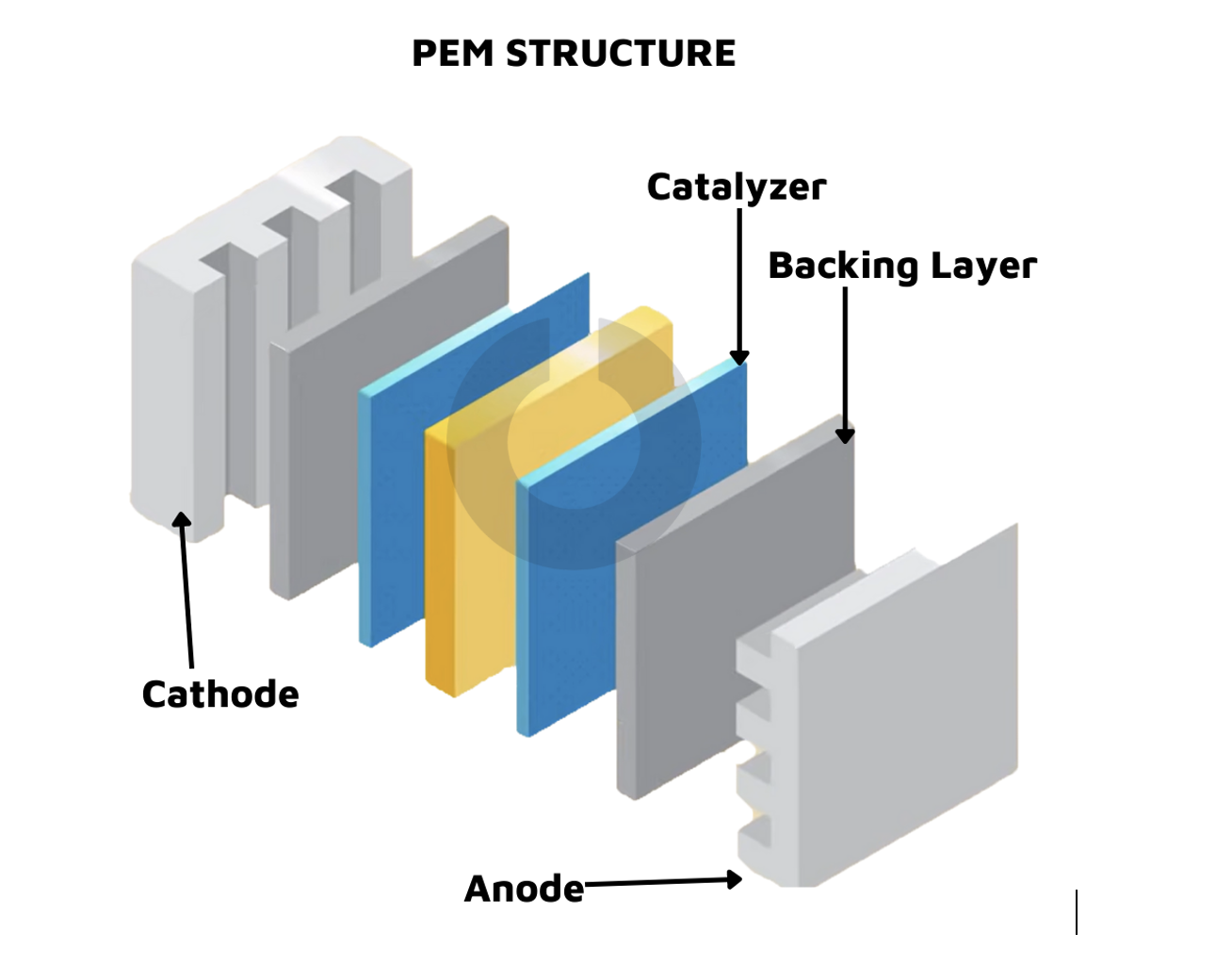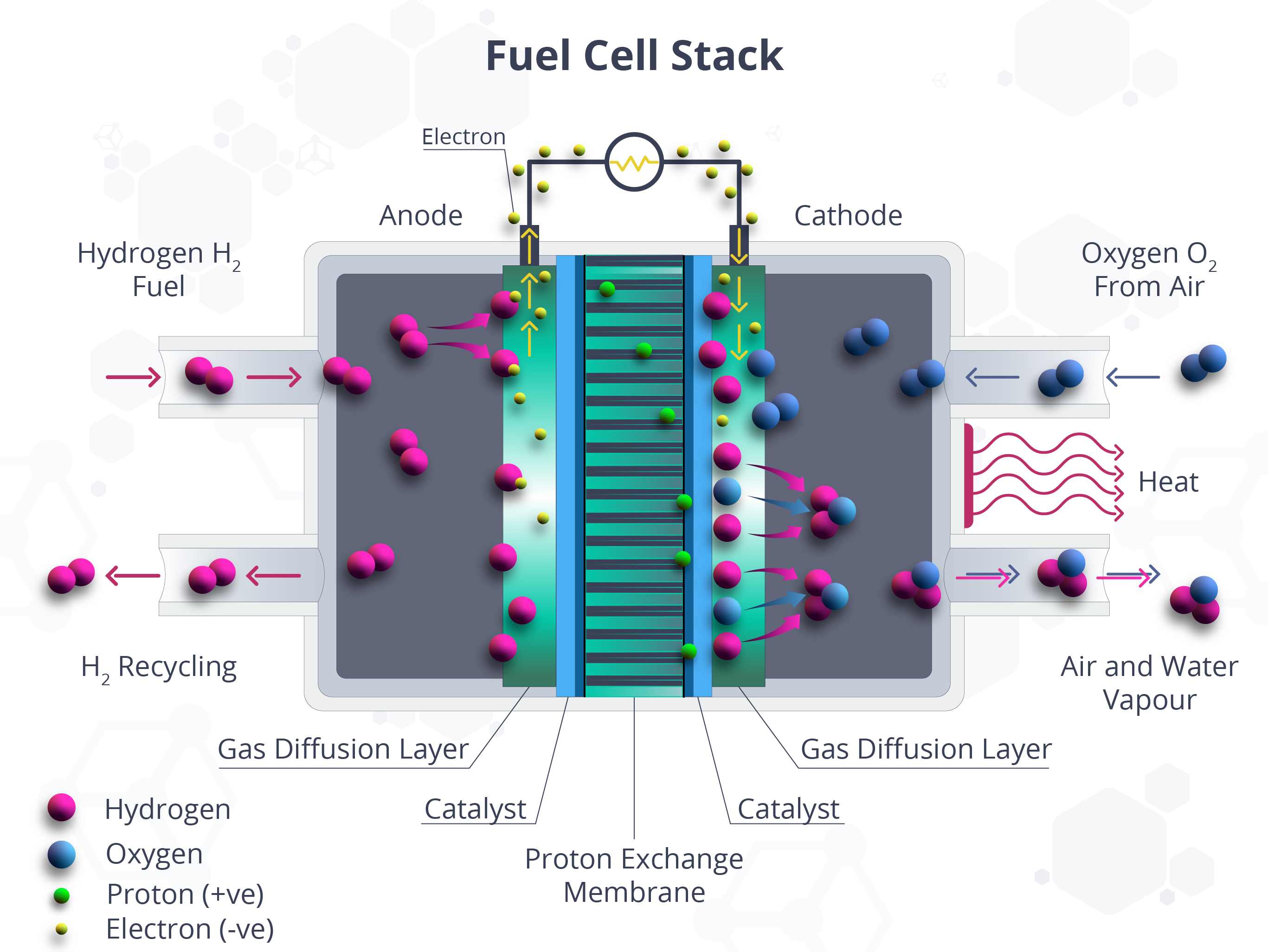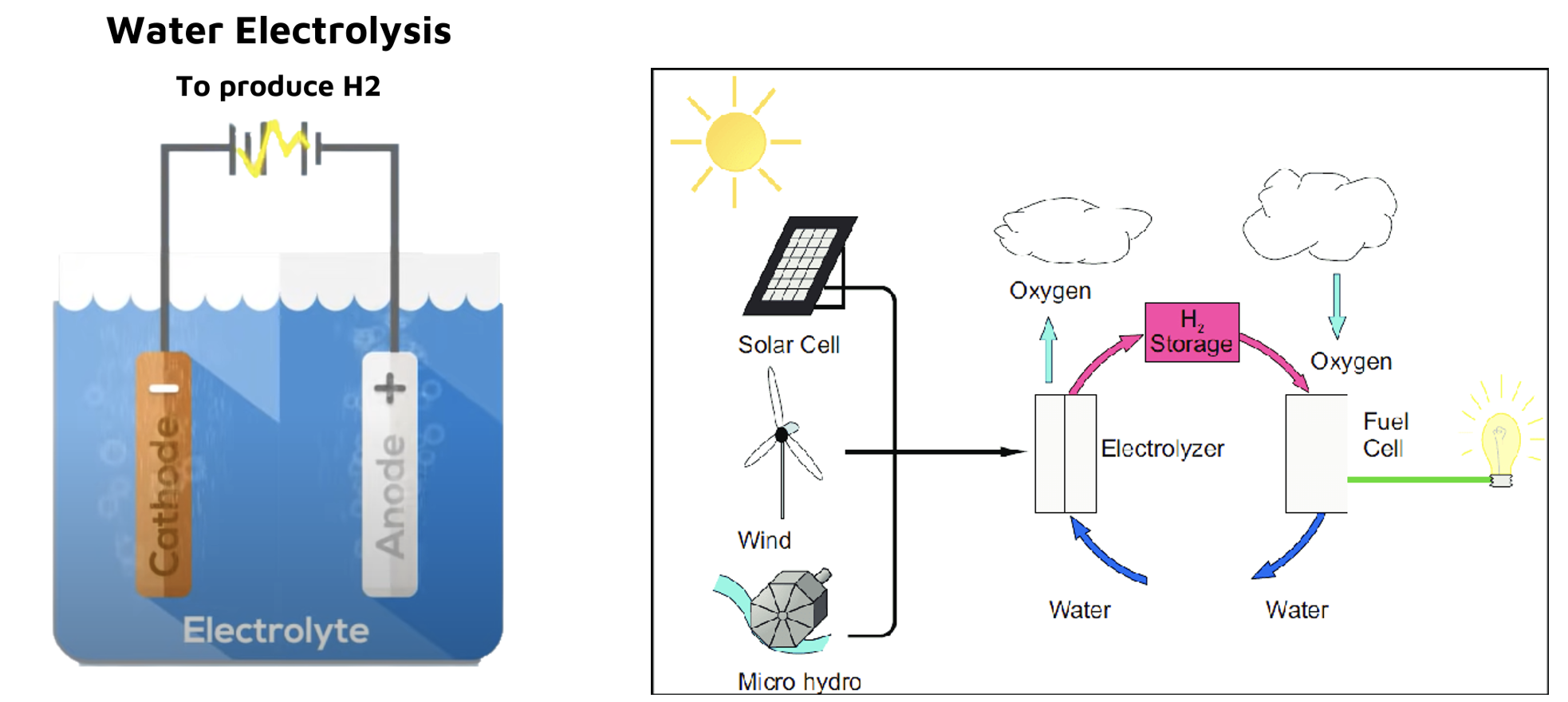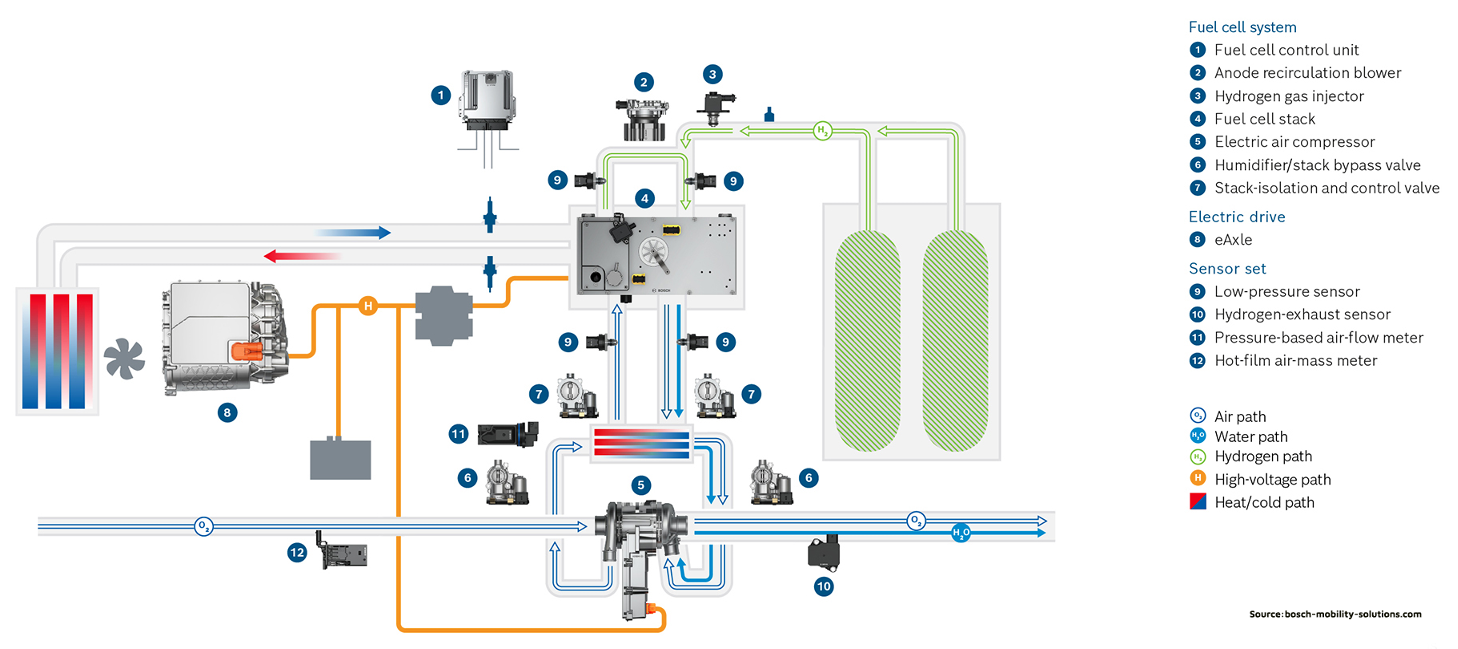What is a fuel cell?
A fuel or energy cell is an electrochemical cell that transforms chemical energy into electricity. Fuel cells differ from batteries. They demand a stable supply of fuel and oxygen to sustain the chemical reaction. Hence, the fuel cells can regularly produce electricity until the fuel and oxygen are supplied to the channel. Because of this, they are ideal for uses where a permanent energy source is necessary, such as giving power to a vehicle or providing emergency power to a household or office. An isolated fuel cell comprises a membrane electrode assembly (MEA) and two charge inflow plates with 0.5 and 1V voltage. Like energy storage batteries, many individual cells are arranged in series to achieve better voltage and strength. This arrangement of cells is called a fuel cell stack or an energy stack.
A fuel cell stack comprises plates and connections for ease of further use. The strength of a given fuel cell stack will depend upon its size. As we are all familiar with, Ohm’s law says voltage is directly proportional to the current, i.e., enhancing the number of cells in a stack unit will increase the voltage, whereas growing the vicinity of the cells will increase the present too.
The fuel or energy cell stack consists of a stack containing up to several hundred energy cells; basically, it forms the core of the energy cell system. When these cells are arranged in series, a “cold combustion” event occurs that further converts the energy from the chemical reaction between the regular feeding of hydrogen and oxygen into electricity. This process happens while hydrogen is broken down further into electrons and protons.
As the polymer membrane transmits protons toward the cathode, electrons move from the anode to the cathode via a group of electrical circuits, producing a stream of electricity. At the cathode, the air’s protons, electrons, and oxygen ultimately respond to create a byproduct – water.

Analysis of the fuel cell stack assembly pressure
A proper stack structure and cell assembly unit are essential to the efficiency of energy cells. The cell assembly will enforce the functioning of the anode and cathode plates with the membrane electrode assembly (MEA). If the assembly pressure is insufficient, it can lead to leakage of charges or energies, and further high contact resistance will lead to the malfunctioning of the fuel cells. High or too much pressure, on the other hand, can damage the gas prolixity subcaste and/or MEA. The fuel cell stack design and structure may affect the balancing of the pressure within the fuel cell stack and hence the inter-surface contact resistance. Unequal distribution of the contact pressure will cause further damage to the cell, which may result in a deteriorating energy cell life.
The structure of fuel cell systems is complex and can change considerably depending on the fuel cell type and the kind of application. However, we are listing some basic building blocks of the fuel cell system as mentioned below:
- Stack of fuel cells or energy cells
- Energy or fuel processor
- Power inverters or conditioners
- Air compressors
- Humidifiers
Stack of fuel cells or energy cells
The fuel cell stack is a fuel cell energy system’s central nervous system. As previously stated, a fuel cell stack is a collection of individual fuel cells aligned in a series to populate energy in greater strength. The electricity is produced in direct current (DC) from electrochemical reactions [electrolyzers] that occur in the fuel cell. A single fuel cell produces < 1 volt of energy, which is inefficient for most applications. Thus, there is a need for an energy amplifier, and here comes the fuel cell stack concept. A typical fuel cell stack may be grouped with hundreds of fuel cells. The energy produced by a fuel cell depends upon many factors, like fuel cell type, cell size, the temperature at which it works, and the pressure of the gases delivered to the cell.

Source:matmatch.com
Energy or a Fuel Processor
The fuel processor processes the fuel and converts it into a usable or ready-to-feed form by the fuel cell. Depending on the energy material and type of fuel cell, the fuel processor removes the filth, such as sorbent or a combination of multiple chemical reactors.
Suppose the system is powered by a hydrogen-rich, conventional fuel, such as methanol or fossil fuels. In that case, a reformer is typically used to convert hydrocarbons into a gas mixture of hydrogen and carbon compounds called “reformate.” A sorbent removes other impurities, such as sulfur [or elements that accumulate molecules] compounds, before they are sent to the fuel cell stack. This process prevents contaminants in the gas from binding with the fuel cell catalysts. The reformate is then transferred in several cases to a set of reactors to turn carbon monoxide into CO2 and eliminate any trace amounts of CO that may be left.
Since making energy via fuel cells using fossil fuels catalyzes and promotes carbon footprints, there is a hope to decarbonize the entire system using renewables and renewable energy as a feedstock to the fuel cell system.

Source: Researchgate
Power inverters or conditioners
They account for the control of current, voltage, frequency, and other characteristics of electric power to fulfil the demands of the system. Fuel cells generate current in the form of a unidirectional or direct current. In a DC circuit system, electrons flow singularly or unidirectionally. The electricity supplied in homes, workplaces, and industries is in the form of alternating current (AC), which flows bidirectionally or in alternating cycles.
If the energy produced from the fuel cell needs to be used via AC-based power equipment, it will require a DC-to-AC converter. Both AC and DC power should be conditioned. Power inverters and conditioners adapt the fuel cell’s electrical current to suit the electric equipment’s electrical needs, whether a simple DC motor or a complex utility power grid. The conversion and conditioning further decrease the system efficiency, which, on a lighter note, is approx—2%–6%.
Air compressors
Fuel cell performance enhances as the pressure of the reactant gases increases, which means the fuel cell performance index is directly proportional to the pressure of the reactant gases. Thus, many fuel cell systems include an air compressor, which raises the pressure of the inlet air to 2–4 times the ambient atmospheric pressure.
Humidifiers
The PEM [polymer electrolyte membrane] at the center of a PEM fuel cell is inefficient if it is dry, so most fuel cell systems are comprised of a humidifier for the feeding air. Humidifiers are usually built from a thin membrane, which may be the same material as the PEM. By streaming dry air on one side of the humidifier and wet exhaust air on the other side, the water yielded by the fuel cell may be recycled to keep the PEM adequately hydrated.
Fuel Cell Stack and EVs
The fuel cell stack is a mechanism to convert the chemical energy of a fuel into electricity through an electrochemical reaction process. An electric vehicle (EV) is powered by one or more electric motors and uses batteries to store electrical energy.
Electric Vehicles and Fuel Cells
As the world gradually shifts away from petrol and diesel cars, electric vehicles are becoming more prominent these days. There are still many questions about pricing, durability, efficiency, how they work, and their benefits.
Fuel cell electric vehicles (FCEVs) are a type of electric vehicle that uses a fuel cell stack to convert hydrogen gas into electricity. This energy is then applied to power an electric vehicle motor that powers the wheels.
FCEVs have numerous advantages over battery electric vehicles (BEVs). First and foremost, they can be refueled much faster than BEVs—it only takes a few minutes to fill up an FCEV, compared to hours for a BEV. Second, FCEVs have a much longer range than BEVs; a typical FCEV can travel 400 miles on a single tank of hydrogen, whereas a BEV can only travel 100 miles on a full charge.
Finally, FCEVs produce zero emissions, and that is countable – the only byproduct of the hydrogen-to-electricity conversion process is water vapor. And that makes them an eco-friendly solution to reduce carbon footprint.
There are currently very few FCEVs in the market, but this is obvious and expected as it will take time to explore the technology and relevant infrastructure.

Renewable Energy
If you are interested in learning about renewable energy, you have landed in the right place. Here in this Fuel Cell Stack article, we are happy to talk about all things related to renewable energy, i.e., from solar and wind power to geothermal and hydroelectricity. Renewable energy is the future, and we’re here to help you learn about it so you can shift to a more sustainable living style.
We know that switching to renewable energy may sound uneasy, but it is crucial for the environment’s health. We will help you see how simple it is to start using renewable energy in your life and provide tips and resources to help you along the way. We hope you will join us on this journey to a cleaner, brighter future.
